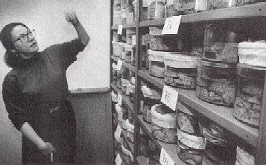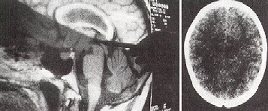ADRIANNE NOE, ABOVE, OF THE NATIONAL MUSEUM OF HEALTH AND MEDICINE, WITH A COLLECTION OF BRAINS PRESERVED FROM ST. ELIZABETHS PATIENT AUTOPSIES; BELOW RIGHT, CAT SCAN OF A NORMAL BRAIN; MRI BRAIN IMAGE
lobotomies; others died. They operated on an alcoholic lawyer and Rhodes scholar who escaped from the hospital on Christmas Eve and was found, drunk, in a downtown Washington bar. Freeman and Watts headquartered their increasingly lucrative private practice in a house at 2014 R St. SW. Watts occupied an office at ground level, their assistant manned the first floor, and Freeman worked upstairs. Lobotomy Patient No. 157 once returned to threaten their lives and two others pulled guns on Freeman when he recommended psychosurgery. As much as some of Freeman's colleagues lamented the practice of damaging healthy brain tissue in order to treat mental illness and the absence of scientific evidence that lobotomy actually worked, doctors were even more critical of Freeman's hunger for public recognition. More than once, AMA members tried to censure him for advertising his services, which was then considered an unethical practice for physicians. The suspect advertising appeared, his accusers said, in the colorful lobotomy exhibits Freeman set up every year from 1939 through the early '40s at the annual AMA convention. Freeman targeted his displays not at other doctors, but at the press. "I found the technique of getting noticed in the papers," he later acknowledged. "It was to arrive a day or two ahead of the opening [of the convention] and install the exhibit in the most graphic manner and then be alert for prowling newsmen." Playing the role of barker, entertainer and scientist, Freeman used hand-held crackers to draw reporters and frequently displayed a lobotomized animal. The results were immediate. Freeman described what happened after journalists viewed the exhibit in 1939: "That night our monkey died but Watts and I made the headlines even though we did not get an award." A photo of Freeman and Watts in the operating room appeared in Time magazine in November 1942, and many other magazines and newspapers published laudatory accounts of, the Freeman-Watts operation. By his own reckoning, 52 percent of their first 623 surgeries yielded "good" results, 32 percent "fair," and 13 percent "poor." Three percent died during or after surgery. At first glance, those results seemed miraculous, given that few other treatments held much promise for hard-core cases of depression, agitation and obsessive behavior. But Freeman and Watts often did not define what they considered improvement to be. Relapses frequently occurred. In addition, a certain number of these cases were bound to get better on their own.
|
And the aftereffects of
lobotomy, separate from the symptoms of mental illness, often crippled the emotions,
inhibitions and personalities of patients. Nurses who cared for Freeman-Watts patients immediately after the operations grew accustomed to dealing with people who needed to be retaught how to eat and use the bathroom. The patients often made clumsy passes at their caregivers, urinated on their shoes, sat unmoving for hours, stubbornly refused to follow instructions and behaved childishly. Nurses learned that spanking and tickling could reliably distract patients from delusions and perceived threats. The most famous failure of Freeman and Watts from this period is Rosemary Kennedy (JFK's sister), who was probably the first mentally retarded person to receive a lobotomy and who has needed full-time care for the past 6o years. Freeman believed that many of these changes were not only acceptable, but also therapeutic. He saw laziness, indifference and dullness as signs that the overcharged emotional impulses of the thalamus had successfully been derailed. The less that patients paid attention to their own troubles, the better. Officials at state mental hospitals and veterans hospitals across the country also found the trade-offs acceptable. (An exception was William Alanson White, superintendent of Freeman's own St. Elizabeths, who never allowed lobotomies in the hospital during his tenure.) Lobotomy arrived on the scene at a time when these institutions overflowed with patients, many of them servicemen who developed mental illnesses during World War II, with no reliable courses of treatment ahead of them. Mental health practitioners desperately needed new therapies. By 1945, however, Freeman was starting to doubt the effectiveness of his standard lobotomy procedure. The damage it caused was undeniable. Its cost and requirement of a skilled neurosurgeon limited its application. Freeman was also rethinking the standard wisdom that lobotomy should be the therapy of last resort. He suspected that people who had been seriously disordered for more than five years were usually too far gone to be helped, and that lobotomy might work best for patients in the early stages of psychiatric illness. His research led him to the work of Amarro Fiarnberti, an Italian psychosurgeon who eliminated the need for boring holes into the skull by breaking through the easily accessible bone at the rear of the eye socket and injecting alcohol or formalin into the brain. Again practicing on cadavers, Freeman altered this technique by replacing the injection with the cuts of a sharp instrument - first an ice pick from his kitchen whose handle bore the name of the Uline Ice Company and later a type of leucotome that he designed and always carried with him in a felt-lined case. Freeman kept his new trans-orbital technique a secret from Watts. In January 1946, he performed the first such operation in his R Street office on a patient named Ellen Ionesco. Eight more followed in quick succession. He often sent patients home in a taxi an hour after the operation. Freeman later wrote that during his 10th trans-orbital surgery, he called Watts to his office to assess the operation. Watts later claimed, however, that he entered Freeman's office unsummoned and found Freeman pushing an ice pick in the eye socket of an unconscious man. |
|

